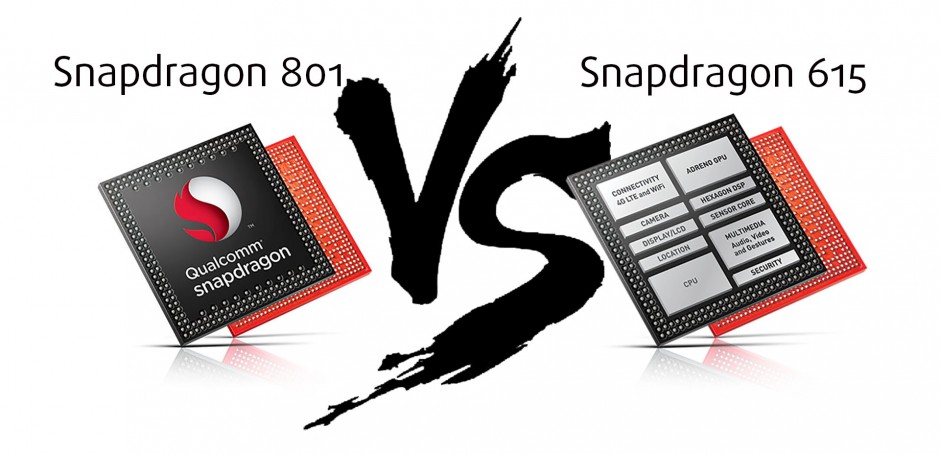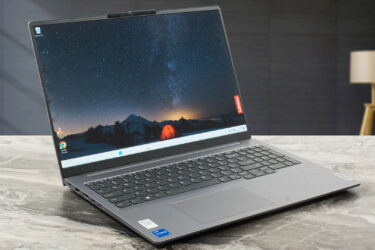Qualcomm Snapdragon 801 (+Adreno 330) vs Snapdragon 615 (+Adreno 405) comparison – performance, specs and benchmark results
In preparation for our Lenovo Vibe Shot review, we decided to compare its SoC (Snapdragon 615) to one of the best SoC’s of 2014 – the Snapdragon 801.

| Qualcomm | Snapdragon 801 |
|---|---|
| Process | 28 nm HPM |
| Cores | 4 |
| Frequency | 2.45 GHZ |
| Architecture | ARMv7 ISA compatible Krait architecture |
| GPU | Adreno 330 / 578 MHz |
| Qualcomm | Snapdragon 615 |
|---|---|
| Process | 28 nm |
| Cores | 4+4 |
| Frequency | 4 х 1.0GHz + 4 x 1.7GHz |
| Architecture | Cortex-A53 / 64-bit capability |
| GPU | Adreno 405 / 550 MHz |
Qualcomm Snapdragon 801 (MSM8974AC) is a high-end ARM-based SoC for smartphones and tablets. It has four Krait 400 cores that can be clocked at up to 2.45 GHz, Adreno 330 GPU with a frequency of up to 578 MHz and is constructed through a 28nm HPM (High Performance Mobile) HKMG manufacturing process. Compared to other Snapdragon 800 chips, the 801 offers higher CPU and GPU clock rates as well as eMMC 5.0 support.
The processor of the S801 SoC is based on Qualcomm’s Krait architecture. It is compatible with the ARMv7 ISA. The high clock rate of up to 2.45 GHz and high performance per MHz offer very strong CPU performance. It was one of the fastest ARM SoCs on the market in 2014. The SoC’s GPU – Adreno 330, can be clocked up to 578 MHz and is significantly faster than the older Adreno 320 (400 vs 450 MHz). Even though both GPUs have the same amount of texture units (8 TMUs), the Adreno 330 has 50% more shaders. The GPU is powerful and faster, but its performance may vary depeding on the device and its cooling. Energy consumption of the Snapdragon 801 SoC is significantly improved compared to its Snapdragon 600 predecessor.
The Snapdragon 801 SoC was used in almost every company’s flagship model in 2014, such as Sony Xperia Z3, HTC One (M8), Samsung Galaxy S5, LG G3 and many more.
[ad_728]
The Snapdragon 615 (MSM8939) used in Lenovo Vibe Shot is a SoC mainly meant for mid-range Android smartphones and tablets. It has eight Cortex-A53 cores grouped into two quad-core clusters. One of the clusters has a maximum clock rate of 1.0 GHz and is used in the less demanding tasks in order to reduce energy consummation, while the other can be clocked up to 1.7GHz, with the main purpose being to handle the heavier, more demanding apps lag-free.
The Adreno 405 GPU, 64-bit capability and a couple of other improvements are all add up to this model’s higher performance per clock.
| Benchmarks | Qualcomm Snapdragon 801 | Qualcomm Snapdragon 615 |
|---|---|---|
| Geekbench 3 (Multi-Core) | 2381 (+1%) | 2357 |
| Vellamo 2 Metal | 1296 (+52%) | 853 |
| GFXBench 2.7 T-Rex (offscreen) | 27.5 (+83%) | 15 |
| GFXBench 3 Manhattan (offscreen) | 11.8 (+100%) | 5.9 |
| 3D Mark Ice Unlimited | 16916 (+118.35%) | 7747 |
The benchmark results of Snapdragon 801 were taken from LG G3 (3GB RAM) and those for the Snapdragon 615 – from Lenovo Vibe Shot’s results.







